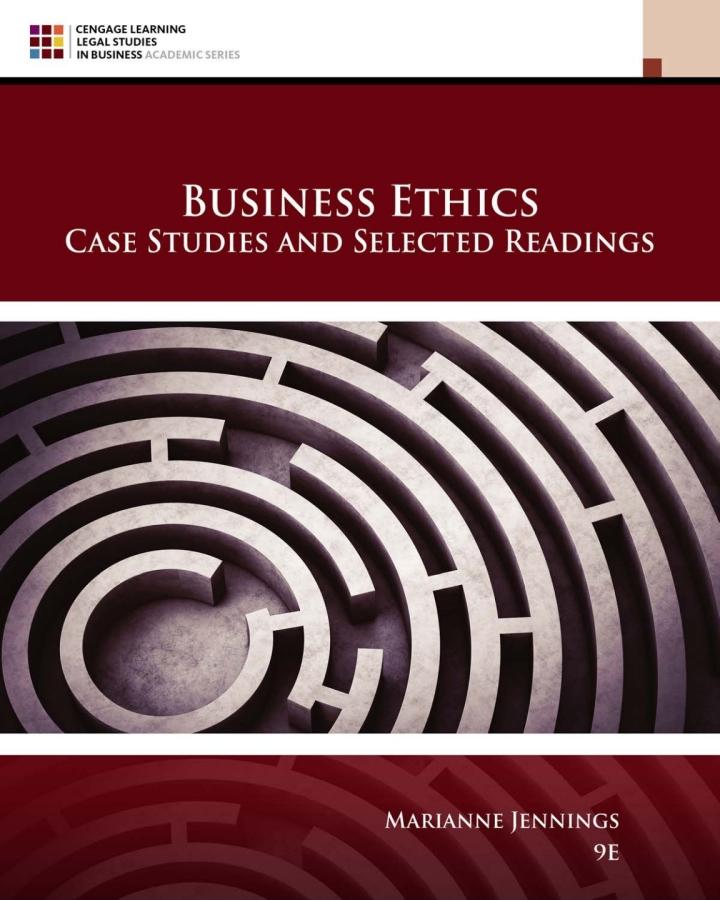It began as a simple exercise to gauge what was on the minds of my students and
Question:
It began as a simple exercise to gauge what was on the minds of my students and training and seminar participants. On the first day of the seminar or class, I gave them two index cards and asked them to do the following:
¢ Describe one thing you did at work during the past year that really bothers you.
e Describe one thing you did in your personal life during the past year that really bothers you.
Note two important things about the exercise. First, participants are asked to do a work and a personal card. For four decades now, one of my greatest challenges has been getting organizations and individuals to see that there is no difference between ethical standards in their personal lives and those at work. If you would not be dishonest with a neighbor in selling her your freezer, you should not be dishonest with a customer, vendor, or regulator at work. Second, the operative word is “bothers,” meaning that they have not remedied what happened or made peace with it.
In the short time given for this challenge, the results were stunning. Just two souls in the thousands who have participated in this exercise since 2010 wrote on a card, “I havent done anything that bothers me.” For the remaining students, 60% of whom are executives with a minimum of 10 years’ business experience, there were cathartic experiences as they used the index-card exercise as an outlet for letting go of their ethical demons.
Herewith, some examples, and, in the words of the great Dave Barry, “I am not making this up”:
Hailing from the academic world, I am quite accustomed to the “in theory” rejections of my work. The irony is that it would appear that most of those surveyed believe themselves to be ethical in theory. They are, however, having some difficulty in application.
“Lost in translation” is an apt description, and an example is in order. In one of my textbooks is a short case study in which two friends who have just seen a movie realize, as they are leaving the theater, that the other theater doors in the multiplex are wide open and that no theater employee is present to monitor patrons. So, the two friends duck in and see two movies for the price of one. The case study, when presented early in the course, nets the usual, “It’s no big deal,” “Everybody does that,” and “Tt doesn’t really hurt anyone.” On occasion I hear, “Hollywood can afford to spring for another movie for me.” However, there will also be a student or two who will pipe up and exclaim, “It’s not right. You didn’t pay.’ Interestingly, the student who chimed in with the moral high ground this past semester came to class one day with a bootleg copy of The Hurt Locker to share with another student. I reminded her of her moralizing on the twofer. “This is different!” she sniffed back.
That “this is different” is where we lose employees in our training and cultures. To bring the Hurt Locker student around, I had to have her return to the methodical tools we use to analyze ethical issues, the tools that force students to go beyond the emotional reactions and relatively shallow opinions we all bring initially to resolving ethical dilemmas. Whos affected by your decision to use a bootleg copy? What would happen if everyone participated in movie bootlegging? Why the producers of The Hurt Locker would make even less money than they did. However, when quality movies do not reflect their real draw and economic power, we are all affected in that producers no longer undertake those projects. When we bootleg or duck in for free, we are not just seeing a movie for free; we are fooling around with the delicate balances in market forces that are dependent on real demand, transparency, and accurate pricing.
In every example my participants gave on their cards, they had engaged in the behavior that ultimately bothered them because they had neglected to do the hard analysis initially:
What are the real costs here? What if everyone does what I am doing? Who else is affected by my decision? For example, on the mortgage application misrepresentation of income confession, a real analysis of that ever-so-slight and ever-so-singular misrepresentation of income, we are forced to internalize just a little bit of responsibility for the Wall Street meltdown.
Risk models on mortgage instruments were built on the assumptions we once made about mortgage applicants, loan approvals, and income verification. When borrowers circumvent those assumptions to obtain a loan, folks up and down the economic chain are affected. Before we blame the greed on Wall Street for our economic strife, we do need a little introspection on our participation and contribution...........................
Discussion Questions 1. Try doing the exercise yourself. Ask friends and fam- 2. What kinds of things could this exercise reveal ily members for examples and discuss with them about an office or workplace?
whether they “fixed” the bother, how, and why.
Step by Step Answer:

Business Ethics Case Studies And Selected Readings
ISBN: 9780357453865
9th Edition
Authors: Marianne M. Jennings





